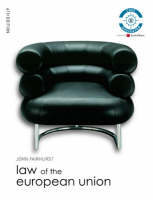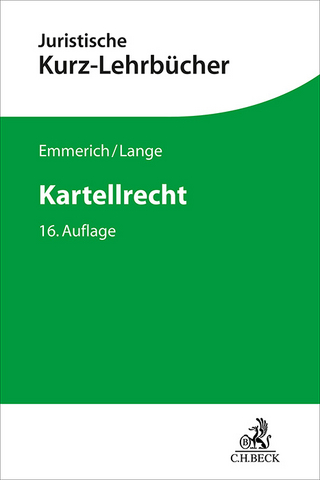
Law of the European Union
Longman (Verlag)
978-1-4058-4688-2 (ISBN)
- Titel ist leider vergriffen;
keine Neuauflage - Artikel merken
Law of the European Union Sixth Edition John Fairhurst The new edition of Law of the European Union has been fully updated to include all recent changes in this rapidly expanding area of the law. The book clearly and accurately explores constitutional and administrative law as well as the major areas of substantive law which are also considered in the context of implementation within the UK. Topics are extensively illustrated with decisions from the European Court of Justice and Court of First Instance enabling students to consider the principles of law in a realistic context. New to this edition *Ratification problems with the proposed Constitutional Treaty and its future. *Incorporation of all the changes to the structure of the European Union following Bulgaria and Romania's accession to the EU on 1 January 2007. *Significant case law development with particular reference to judicial review, state liability and EU citizenship. *Detailed examination of Directive 2004/38 on the right of entry and residence of EU citizens and their family members. *Consideration of Directive 2005/36 on the recognition of professional qualifications.
Key features *Clearly distinguished case summaries encourage students to quickly recognize the key cases and differentiate them from surrounding commentary. *New two colour text design and larger format enable students to follow the text with ease. *Chapter summaries highlight the main points covered in each chapter, cementing understanding. *Concise, comprehensive coverage combined with a clear principle led approach. *Four part structure which clearly highlights the main topics covered. Online Support Companion Website (www.pearsoned.co.uk/fsls) offers students: *Bi-annual legal updates. *Tutorial style questions and answers for each topic covered in the textbook. *Self-test multiple-choice questions to help students assess their progress. *Glossary of legal and commonly-used EU terms. *Web links to online European Law resources. *Flashcards designed to test understanding of key vocabulary. *Lecturers are supported through access to a new European Law Testbank. John Fairhurst BA PgDip MPhil Solicitor is Associate Dean (Staff and Student Experience), Faculty of Arts, Law and Social Sciences at Anglia Ruskin University.
He was previously a Jean Monnet Tutor in EU Law and Course Director of the Diploma of Law (CPE) programme at the University of Huddersfield.
Preface Table of cases before the European Court of Justice and the Court of First Instance (numerical) Table of cases before the European Court of Justice and the Court of First Instance (alphabetical) Table of cases before the European Court of Human Rights Table of cases before national courts Table of European Commission decisions Table of European Community treaties Table of equivalences referred to in Article 12 of the Treaty of Amsterdam(renumbered Articles of the EC) Table of other treaties Table of European Community Regulations Table of European Community directives Rules of procedure of the European Court of Justice Table of statutes Table of statutory instruments List of abbreviations PART 1: CONSTITUTIONAL AND ADMINISTRATIVE LAW OF THE EUROPEAN COMMUNITIES AND THE EUROPEAN UNION 1. An Introduction to the European Communities and the European Union Aims and objectives The post-war years 23 July 1952: the European Coal and Steel Community 1 July 1958: the European Economic Communityand the European Atomic 8 April 1965: the merger of the institutions 1 July 1973: enlargement 1 January 1981: enlargement 1 January 1986: enlargement 1 July 1987: the Single European Act 1 November 1993: the Treaty on European Union 1 January 1995: enlargement 1 May 1999: the Treaty of Amsterdam 1 February 2003: the Treaty of Nice 1 May 2004: enlargement 1 January 2007: enlargement Future enlargement The Charter of Fundamental Rights of the European Union The Constitutional Treaty A two-speed Europe? The EuropeEconomic Area The Council of Europe, the European Convention on Human Rights and Court of Human Rights: a structure outside the Communities and the Union Summary References Further reading 2. Sources of Community Law Aims and objectives The sources of Community law The treaties establishing the European Communities and the European Union Secondary legislation made under the treaties Soft law Related treaties made between member states International treaties negotiated by the Community under powers conferredby the treaty Decisions of the European Court of Justice and Court of First Instance General principles of law and fundamental rights upon which the constitutional laws of the member states are based Summary References Further reading 3. Community institutions and related bodies Aims and objectives Article 7 EC Treaty The European Council The European Commission The Council of Ministers Coreper The European Parliament Court of Auditors The Economic and Social Committee ( ECOSOC') The Committee of The Regions The European Central Bank and the European Investment Bank Summary References Further Reading 4. The decision-making process Aims and objectives Decision-making within the Community Constitutional Treaty Dialogue between Commission, Council and Parliament Legislative proposals Voting procedures The legislative process The involvement of the UK Parliament The appropriate legal base Subsidiarity Summary References Further Reading 5. The European Court of Justice and the Court of First Instance Aims and objectives Statute of the Court of Justice and the rules of procedure Organisation of the Court of Justice Precedent Methods of interpretation The Court of First Instance EU Civil Service Tribunal The Jurisdiction of the European Court of Justice and the Court of First Instance Summary References Further Reading 6. Preliminary ruling jurisdiction of the Court of Justice (Article 234 EC Treaty) Aims and objectives Introduction to the Court of Justice's preliminary ruling jurisdiction References from national courts under Article 234 EC Treaty Flowchart: the Article 234 EC preliminary ruling jurisdiction of the Court of Justice Summary References Further reading 7. Direct actions against member states (Articles 226 228 EC Treaty) Aims and objectives The obligation of member states under the EC Treaty The stages of Article 226 proceedings Article 228 pecuniary penalty Interim measures Other actions against member states Summary References Further reading 8. Judicial review of Acts of Community institutions Aims and objectives Legality of community acts: Article 230 EC treaty Challenging a failure to act: Article 232 EC treaty Claims for damages against Community institutions for unlawful acts: Article 288 EC Summary References Further reading 9. Principles of supremacy, direct effect, indirect effect and state liability Aims and objectives The supremacy of Community law Article 226 EC Treaty ineffective means of enforcement Development of Community law principles The principle of direct effect The principle of indirect effect The principle of state liability Application of the principles of direct and indirect effect in UK Courts Unimplemented directives: a continuing problem Enforcement of a directive in the national courts: the correct approach Summary References Further Reading 10. Applying community law in the English courts and adapting English remedies to the requirements of Community law Aims and objectives The community approach to legal remedies Public law remedies: judicial review Claims in tort against the state Claims in tort between private individuals for breaches of treaty provisions Community law as the basis for a claim in contract, a defence in breach of contract proceedings, and for claims in quasi-contract Community law as a defence in criminal proceedings Summary References Further reading PART 2THE FREE MOVEMENT OF PERSONS AND SERVICES, AND RIGHTS OF ESTABLISHMENT 11. European Union citizenship and free movement rights Aims and objectives Introduction to the free movement of persons EU citizenship Free movement rights Directive 2004/38: Right of entry and residence Other rights derived from EU citizenship Free movement rights of non-EU citizens The Schengen Acquis and its integration into the European Union Summary Further reading 12. Free movement of workers Aims and objectives Introduction to the free movement of workers Scope of the term worker' Work-seekers The worker's family The exercise of workers' rights Equal access to employment, housing, education and social rights under regulation 1612/6 May 2004 enlargement transitional arrangements January 2007 enlargement transitional arrangements Summary References Further reading 13. Freedom of establishment and the provision and receipt of services Aims and objectives The EC Treaty and Directive 2004/38 Recipients of services The provision of services and rights of establishment Obstacles to establishment Rights of entry and residence Equal treatment The official authority exception Professional qualifications Other qualifications Directive 2005/36: the recognition of professional qualifications Future developments Summary Further reading 14. Social security Aims and objectives Introduction to social security The beneficiaries of the regulations The principles of Article 42 EC Treaty Sore developments Social security and social assistance in the UK Summary References Further reading 15. Limitations on the free movement of persons Aims and objectives The EC Treaty and Directive 2004/38 Public policy and public security Public health Procedural protection The Schengen Agreement and Directive 2004/38 Summary Further reading 16. Free movement rights in the United Kingt: the island problem Scope of the Immigration (European Economic Area) Regulations 2006 Transportation table: Directive 2004/38 and the EEA Regulations 2006 Summary Further reading PART 3THE FREE MOVEMENT OF GOODS 17. Custom duties and internal taxation Aims and objectives Introduction to the free movement of goods Articles 23 and 25 EC Treaty: the elimination of border charges and fiscal barriers Flowchart: Article 25 EC Treaty Customs duty or internal taxation Article 90 EC Treaty: discriminatory and protectionist internal taxation Flowchart: Article 90 EC Treaty Summary Further reading 18. The elimination of quantitative restrictions and measures having an equivalent effect Aims and objectives An introduction to Articles 28 30 EC Treaty State measures Quantitative restrictions Measures having equivalent effect to quantitative restrictions (MEQRS) Distinctly applicable measures Article 29 EC Treaty: exports Article 30 EC Treaty: Defences to distinctly and indistinctly applicable measures Article 30 EC Treaty and the UK's implementation of the free movement of goods The Cassis Rule of Reason: Defences to distinctly and indistinctly applicable measures Overcoming barriers created by differing national standards Flowchart: Articles 28 and 30 EC Treaty Summary Further reading PART 4:COMPETITION LAW 19. State monopolies and state aid Aims and objectives Introduction to state monopolies and state aid State monopolies State aid The Commission's role of monitoring the grant of state aid Summary References Further reading 20. Cartels and restrictive agreements (Article 81 EC Treaty) Aims and objectives Competition law and policy Article 81 EC Treaty Summary References Further reading 21. Abuse of a dominant position and mergers (Article 82 EC Treaty) Aims and objectives Abuse of a dominant position A dominant position Abuse of a dominant position Affecting trade between member states Relationship between Articles 81(1) and 82: collective dominance? Mergers Summary Further reading 22. Enforcement of competition law: powers and procedures Aims and objectives Introduction Initiating action by the Commission and the member states Applications by parties to a possible infringement The provision of information Powers of investigation The right to a hearing The decision Fines and periodic penalty payments Relationship between the Commission, and the competition authorities and courts of the member states The role of national competition authorities and courts in the enforcement of Community competition law Relationship between the Community and national competition law Summary References Further reading Index
| Erscheint lt. Verlag | 26.4.2007 |
|---|---|
| Reihe/Serie | Foundation Studies in Law Series |
| Verlagsort | Harlow |
| Sprache | englisch |
| Maße | 186 x 246 mm |
| Gewicht | 1612 g |
| Themenwelt | Recht / Steuern ► Allgemeines / Lexika |
| Recht / Steuern ► EU / Internationales Recht | |
| Recht / Steuern ► Privatrecht / Bürgerliches Recht | |
| Recht / Steuern ► Wirtschaftsrecht ► Wettbewerbsrecht | |
| ISBN-10 | 1-4058-4688-7 / 1405846887 |
| ISBN-13 | 978-1-4058-4688-2 / 9781405846882 |
| Zustand | Neuware |
| Haben Sie eine Frage zum Produkt? |
aus dem Bereich


